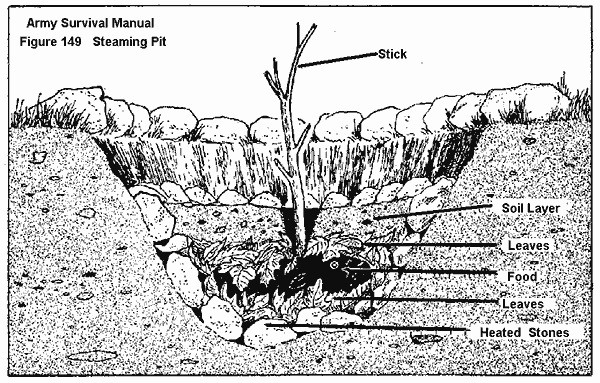Here are 5 common yet primitive cooking methods that are seriously good to know should the grid go down. Knowing these techniques and more will help you be able to provide and cook for your family when SHTF. Plus, besides being effective they are also rather compelling! Take a look:
Broiling
Broiling over a fire isn’t that much different than broiling in your oven.
The only difference is that, over a fire, you might not have a pan to lay the food in, so you’ll need to set something up that can hold the food over the fire without it falling in.
River birch and willow are great woods you can use for broiling over an open fire because they are flexible, and flexibility is key when trying to find the right kind of wood for this type of cooking. You might also need a couple of pieces of the same type of wood; the more you have, the more effective your cooking device will be.Hot Stone Cooking
Cooking on a hot stone is really no different than cooking in a frying pan. Using a flat surface such as a rock, you just have to heat it up, place your food on, and then heat it up a little more. Be sure that the rock is dry, so it will heat up faster, and that it has at least one flat side so your food doesn’t fall off. Give it a quick clean by dusting it off with a cloth and make sure it’s thicker than one inch, so that it doesn’t crack when heated to extreme temperatures.
You can cook with stone one of two ways. You can either use a small stone for a single serving, or you can place many stones over a low and wide fire, using them to cook larger quantities or larger pieces of food.Steam Pit Cooking
Steam pit cooking is a form of survival cooking that has been used for centuries. You must start by wrapping the food in large leaves, just as you do when ash cooking, and then you need a place where you can build a pit large enough to hold coals and the food.
When digging the pit, make sure you dig it at least a foot to two feet deep. This will be large enough to not only hold the food, but also make sure no steam escapes while cooking. Once the pit has been dug, line the bottom of it with charcoal. Light the coal, again just like you did when ash cooking, and wait for it to get very hot and then die down. Then, place your food over top of the coals and then cover it with the earth you dug up.Spit Cooking
If you’ve ever checked out a whole chicken spinning slowly on a rotisserie, you’ve already seen spit cooking firsthand. There are both horizontal and vertical spits and if you want the metal rods equipped with teeth that help hold the meat, you’ll likely have to already be carrying this as you won’t find anything like it in nature. But, you can create your own spit just by finding a strong, long, and sturdy piece of wood.
While tying a piece of meat onto a piece of wood and turning it over an open fire sounds easy, spit cooking does come with its own unique set of issues. To begin with, any meat that can be tied to the spit must be tied to the spit. Use wire, vines, or twine to really secure the meat onto the spit. If you’re roasting a whole animal, also be sure to tie up the limbs. If you don’t the center of gravity will be thrown off and the meat will once again bounce around the spit instead of clinging to it.Clay Cooking
Some think that our earliest ancestors cooked in clay, but that’s just not the case. By the time clay tools were introduced, humans had already been cooking for generations. But you don’t need to carry around a clay pot that’s prone to breaking while backpacking – dig far enough and you’ll find it. Just make sure that the area you dig for the clay wasn’t once the place of toxic chemicals – such as being the former site of a gas station.
These are not the only ways to cook and you can read up on more on Ask a Prepper. Once there be sure to check out additional information on some of the above mentioned ways of primitive cooking.
Even if you are not partial to hiking or camping, living outside of your homestead, exercising some of the above methods in your backyard is not unheard of. It’s a learning experience and we cannot emphasize enough how important new cooking technique will aid you and your family when the SHTF.
Featured Image via Army Survival Manual

I cooked a have javalina in a pit barbeque, but in the desert leaves are hard to find, so we use moistened guny sacks in place of the leafs.
Corey Canna Millard
Mark Torres